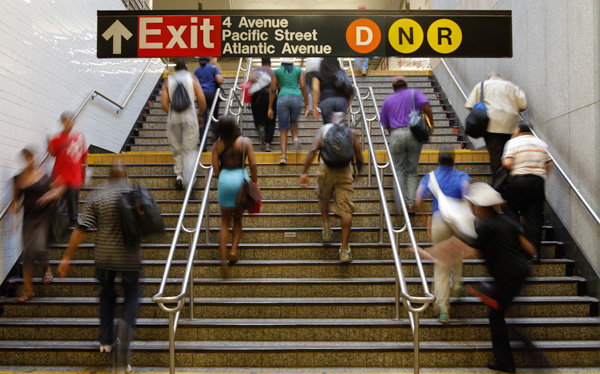
Photo by: Marc Fader
Were there a sustained increase in passenger numbers, the mass transit network could expand to absorb the increase by running more trains and setting up new bus routes. But some parts of the system are already at capacity.
Slashing tolls for drivers is the biggest idea in New York City transportation right now.
A new plan, from the transit advocacy group Move NY, would turn New York driving on its head. Hefty tolls on bridges linking the outer boroughs, like the Verrazano and the Whitestone, would be $5 cheaper under the proposal. Meanwhile, the big free spans into Manhattan, like the Williamsburg and Brooklyn Bridges, would suddenly soak drivers for $10.66 round trip.
Move NY wants the toll cuts on some bridges because it says drivers coming from those areas often have no viable mass transit alternatives. It’s “unfair” that the tolls of outer borough drivers “fund a transit system that generally doesn’t serve them well,” according to the transit advocacy group’s proposal, which was cooked up by former traffic commissioner Sam Schwartz. Move NY wants the new East River tolls because drivers coming from those directions often have tons of mass transit options.
Tolls are sometimes understood as a way to discourage people from driving and push them to mass transit. But the truth is more complicated. Many of those who drive to work don’t have good public transit options, and there are scant plans to provide new ones. There are parts of the transit system that are already at or over capacity that couldn’t absorb drivers if they did leave their cars at home. And just to keep the existing transit system running, New York needs drivers to keep driving, even as gas prices climb, roads worsen and tolls rise more than twice as fast as transit fares.
A lack of options
The city’s public transit ridership continues to rise—up from 51 percent of commuters in 2000 to 55, according to the latest numbers. But more than one in four New Yorkers still rides in a car to work.
Drivers can generally afford to keep driving—New York households with cars (who may or may not use them to commute) make about twice as much money as those that don’t, according to a Tri-State Transportation Campaign study. That makes them less sensitive to price increases, and raises the possibility that drivers with transit alternatives still drive just because they like it.
But transit advocates think people drive because they have to. Maps assembled by the Pratt Center for Community Development show car ownership overlaps with where public transit doesn’t go. They argue for the need for drivers to pay their share for car infrastructure, and to subsidize public transit. But Pratt’s policy director Joan Byron explained that hiking tolls can only do so much to cut down on driving. People generally get behind the wheel because they have no reasonable alternative.
“I’m not a behavioral engineer,” Byron said. Drivers “need to have the options available to them improved.”
That’s not happening anytime soon. The city is expanding express bus service to some areas lacking public transit, but the plans are limited in scope. Big ideas like the Triboro RX, a subway line along a grand arc from Bay Ridge to Yankee Stadium, are a pipe dream.
And so public transit continues to fail to serve the needs of a solid chunk of New Yorkers. More than one in ten city residents commutes from a borough other than Manhattan to another borough other than Manhattan, according to census data from 2000. That’s sometimes a circuitous, awful trip on public transit. Another four in ten commute within their own outer borough, which can be similarly trying if they’re not going along the axis to Manhattan, or somewhere very local. Another eight percent commute out of the city.
No seats available
The MTA’s current ridership has reason to hope people keep driving: In many cases, there’s no more room. Half a dozen subway lines were already overstuffed or at capacity seven years ago—and at rush hour, the tracks couldn’t fit any more trains.
The Authority measures the intimacy of one’s ride using what it calls “loading guidelines.” Denser loads are the new normal. Before 2010, the guideline for non-rush hour trains called for every rider to get a seat. Now it’s within guidelines if up to 18 people are left standing. “Sort of gives you an idea of what they think of their riders,” says Cate Contino with the Straphangers Campaign
And the MTA’s budget depends in part on drivers. Sixty three cents out of every toll dollar collected in 2011 funded public transit, The Journal News reported. That added up to nearly $950 million—about ten percent of the money the Authority spent running public transit that year.
Transit groups are quick to point out that drivers need public transit, because it keeps people off the road who otherwise might drive and worsen traffic. But the way the city and the state fund transportation, riders need drivers too.
It’s an ugly, rusting codependency. And it’s helped forge an unlikely coalition behind Move NY’s plan. Groups from AAA to Straphangers had kind words for it, and Mayor de Blasio called its ideas “interesting and innovative” in an interview with CBS. But Gov. Cuomo hasn’t commented on the plan, and Albany is where it will ultimately live or die.








